April is Prevention of Lyme Disease in Dogs Month. Call our office to chat about what you should be doing to prevent Lyme and other vector-borne diseases in your pets. After reading this article, we have a feeling you’ll want to call us pretty quickly!
April showers bring… ticks? While that may not be how the old adage goes, it’s true that as the weather warms, you and your loved ones (including your furry family members) are at increased risk of coming into contact with ticks and being exposed to all the nastiness that accompanies them, including Lyme disease.
How can my dog get Lyme?
Lyme disease is vector-borne disease, meaning it is transmitted through the bite of an infected arthropod (mosquito, tick, etc.). When an infected tick bites your dog, the infection spreads to your dog’s tissues.
Lyme disease has been found all over the world, with the exception of Antarctica. In the U.S., it is most common in the upper Midwestern states, the Atlantic seaboard, and the Pacific coastal states.
How will I know if my dog has Lyme disease?
The signs of Lyme in dogs may not appear until several months after the initial tick bite, and, even then, can be difficult to detect and diagnose. Sometimes the signs are fleeting and will often mimic other health conditions. Lyme disease in dogs can vary from mild to severe, but the severe cases can lead to kidney failure, heart disease, nervous system complications, and even death.
Watch your dog for:
- Recurrent lameness
- Loss of appetite
- Depression
- Fatigue
- Reluctance to move
- Increased urination and thirst
- Difficulty breathing
How is Lyme treated?
Because Lyme is a bacterial infection, antibiotics will be prescribed, usually for a period of about 4 weeks. In some cases, antibiotic treatment won’t always completely eliminate the bacteria and symptoms could return.
How can I prevent my dog from getting Lyme?
Like with many medical conditions, prevention is key. Your dog should be on a regular flea/tick preventive. There is also a Lyme vaccine available.
Avoid environments where ticks thrive, including tall grassy areas. Regularly check your dog for ticks, and, if you find one, remove it by hand.

